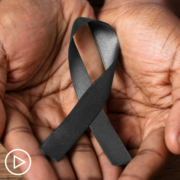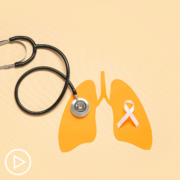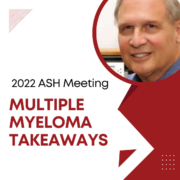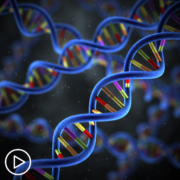A Review of Current Advanced Non-Melanoma Skin Cancer Treatment Options
A Review of Advanced Non-Melanoma Skin Cancer Treatment Options from Patient Empowerment Network on Vimeo.
How is advanced non-melanoma skin cancer currently treated? Skin cancer expert Dr. Vernon Sondak reviews advanced non-melanoma skin cancer treatment approaches.
Related Resources:

|

|

How Can Advanced Non-Melanoma Skin Cancer Patients Participate in Their Care? |
Transcript:
Katherine:
Yeah. Let’s turn now to the treatment options for advanced disease. What approaches are currently available to treat advanced non-melanoma skin cancer?
First and foremost, we always think about, can this thing be entirely removed? Can we get the cancer out and cure the patient once and for all with an operation?
Most skin cancers have not yet spread to the lymph nodes or beyond, even when they’re advanced. So, it follows that if we can remove every last cancer cell from that site, we can cure that patient. That is obviously a worthwhile goal.
But these skin cancers occur in places where a big enough surgery to remove all the cancer can be a pretty deforming surgery. It’s why plastic surgeons get involved a lot. But it’s also why we try combinations of therapy to see if we can get by with less surgery, less radical surgery. Perhaps by adding radiation or adding drug treatments to shrink the cancer.
So, surgery first. Can we do it? Can we just fix this once and for all with surgery and get it done? Whether it’s Mohs, for more advanced cases, usually a general anesthesia type surgery. Often with a skin graft or other kind of plastic surgery reconstruction. Could we just get it all out and have the pathologist tell us, “This is done. This is taken care of”? It’s not a guarantee. There’s no guarantees in this business. Only in the muffler business.
But the odds are good if the pathologist tells us the margins are completely negative. If the pathologist tells us the margins are close here, or positive there, and we don’t think removal of additional tissue is wise, then we may call in the radiation oncologist and say, “Let’s give radiation.” Kill that area where there was a positive margin and give us a margin of safety around the surgery.
In the minority of cases, we say, “This is too big to even tackle with surgery – at least at first – or two widespread. So, we’re gonna use drug treatments. If it shrinks, we may use radiation for surgery later. But first, drugs and let’s see what happens after that.”
So, today we have really three main categories of drug therapy. In the old days we had – and it wasn’t that long ago – we had really one category. I’d say that’s only been in the last – not even – ten years that we’ve had multiple options. But let’s go back 10 years.
Chemotherapy. Standard chemotherapy that people think about with cancer. Hair falls out, nausea as a prominent side effect, suppressing of your immune system, suppressing of your blood counts. That form of chemotherapy was really the only drug therapy we had for advanced melanoma. I mean, advanced non-melanoma skin cancer. Advanced melanoma too could years or more ago.
Now, through progress with melanoma, we have drugs that work in the other kinds of skin cancer. Immunotherapy took the world by storm. It worked so well for melanoma that we tried it in squamous, and merkel cell, and even basal cell cancers, and also saw great results. Now immune therapy is approved in all three of those types of non-melanoma skin cancer.
But there are problems with immune therapy if you have an altered immune system. Especially if you have a kidney transplant, or liver transplant, heart transplant, and we boost your immune system, we run a serious risk of rejection. It isn’t a guarantee, and it can sometimes be managed with additional medications. But it’s something that we have to be very, very, very cautious about, is using immune therapy in someone with a transplant.
So, targeted therapy works when we have a genetic abnormality in a cancer, that we know is only in the cancer, and that we have a drug that can block. For melanoma, if it has a BRAF mutation, we have targeted therapy drugs that target the BRAF mutation.
But non-melanoma skin cancers don’t have BRAF mutations. Squamous cell cancers don’t have mutations that today we can target. Only basal cell cancer, along with melanoma, has a mutation that we can target.
But unlike melanoma – where only some melanomas have the gene mutation in BRAF – basal cells, all the cancers have a mutation in the hedgehog pathway. You can’t pretty much have a basal cell cancer without having a mutation in the hedgehog pathway. Fortunately, we have pills that inhibit that pathway that we call hedgehog inhibitors. Vismodegib, sonidegib, and these drugs are very effective at shrinking even gigantic basal cell cancers.
But the problem with targeted therapy in general, compared to immune therapy, is that the responses don’t tend to last as long. The tumor will shrink very rapidly. But some of those cancer cells figure out a way to mutate further and avoid the drugs that we were using to treat them, and eventually grow back.
Let me just correct one thing I said about targeted therapy, so I don’t leave the wrong impression. I said there’s not really mutations in squamous cell cancer that can be targeted. There is one called the EGF receptor, or EGFR, that we sometimes target with a drug called cetuximab.
It’s not used as much now with immunotherapy. But it turns out there is some targeted therapy, even for squamous cell cancers. But for basal cell, is where the hedgehog inhibitors are used much more effectively than targeted therapy in most other forms of skin cancer.










